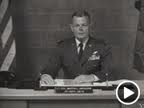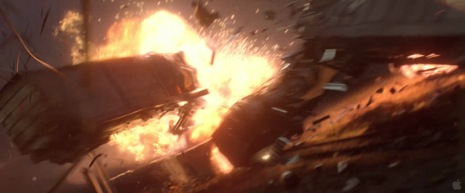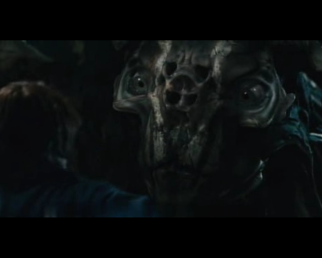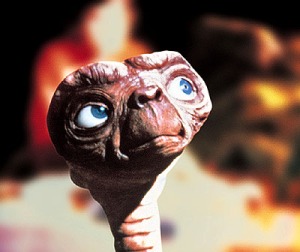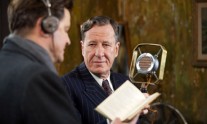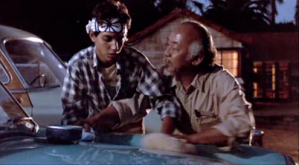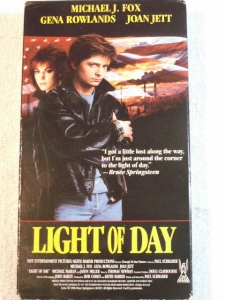The Whiplash of UHF
On the same day, a while back, I went to see Whiplash and then came home and ended up re-watching UHF for the umpteenth time. I’m hoping that this, the very first ever video essay made by me and the first ever video essay addition to Pancake Dominion, will speak for itself:
Mother, Sausalito, Albert Brooks, Dad, and the News
Last night, the following two media items were in a pile on my computer desk:

Item #1. Mother, d. Albert Brooks (1996) on VHS tape.
Mother is a pretty decent movie. Its value in this format on Amazon is virtually nil. The movie itself is not that easy to download, or wasn’t when I checked. I decided to keep it. I’d watched it just a few months earlier. Albert Brooks is John Henderson in the movie; Beatrice, his mother, is played by Debbie Reynolds. As you can gather from the end of this clip, Beatrice, the mother in Mother itself, lives in Sausalito, California, and the film was shot there on location, among other places.

Item #2: Time Flies…The Best of Huey Lewis & the News (1996) on CD.
Here again, the Amazon value of this item is virtually nil. I considered just ripping it to mp3. I like several Huey Lewis songs. True, the image on the CD itself, of Huey mid-jump during a live set, is kind of great. As I flipped through the CD booklet, I gathered that Huey Lewis & the News were a San Francisco-based band. I’d never thought of them that way, but there it was, in black and white. Next, I figured I’d find out whether one of my dad’s favorite Huey Lewis recordings had made this particular Best Of disc. And sure enough, there it was, track #10: “It’s Alright,” an a cappella take on a Curtis Mayfield song. Finally, I read the small-print recording info under the track title listing:
This 1993 recording of “It’s Alright” had been set to tape in Sausalito, California, at a studio called Muther’s Recording.
I decided to keep the CD, too.
Django’s Unchained Camera
I didn’t come up with this, but it’s just the kind of Pancake Dominion observation I haven’t myself made in a long while:

Shortest Possible Review™ Volume #2
Whether you think The Hunger Games (Ross, 2012) is:
A) a rousing critique on the way authoritarian regimes use gladiatorial mass media spectacles to foster public obedience, or….
B) a really depressing and effective example of just such a spectacle in action….
….here is your Shortest Possible Review™:
“The Hunger Tames”
The “Peppy Miller = Penelope Ann Miller?” Post of Imagery and Fact
I have one main Pancake Dominion-type thought about The Artist and the character Peppy Miller, and then just a bunch of other thoughts. Perhaps it’s best to present it all as a set of discrete facts and images. You should watch The Artist before reading any of this, because of *SPOILERS*:
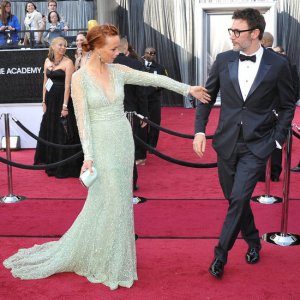
• Michel Hazanavicius is the screenwriter and director of The Artist. He has been married to Berenice Bejo for several years.
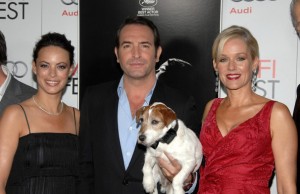
• The Artist features Berenice Bejo as Peppy Miller, Jean Dujardin as George Valentin, and Penelope Ann Miller as George's wife Doris.
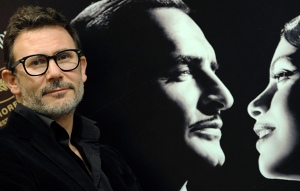
• According to Hazanavicius, "The character George Valentin is my fantasy about Jean, and Peppy is my fantasy about Bérénice. It's the way I see them." He's also hinted that George Valentin was partially based on John Gilbert, a silent film star who once rivaled Rudolph Valentino as the silver screen's "great lover" but whose career was imperiled during the onset of the talkies.

• For much of The Artist, George Valentin is a fallen-film-idol-turned-filmmaker who believes himself deserving of more success than he has recently achieved. In that way at least, George is a reasonable stand-in for Michel Hazanavicius himself, a filmmaker of moderate success prior to the release of The Artist.
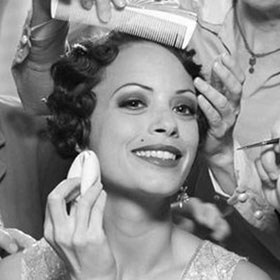
• Berenice Bejo's character in The Artist is named Peppy Miller. Peppy Miller ascends to become a hugely popular movie star after having been accidentally discovered by George Valentin.
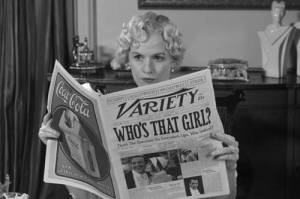
• Penelope Ann Miller appears in The Artist as Doris, the increasingly disaffected wife of silent film star George Valentin, played by Jean Dujardin. (For more on the name "Doris," see the very bottom of this post.)
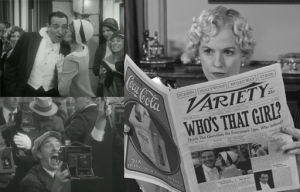
• In The Artist, George Valentin—the film's stand-in for director Hazanavicius—sees the crumbling of his relationship with Doris, played by Penelope Ann Miller, which puts George on the path toward a closer relationship with Peppy Miller, the film's stand-in for Berenice Bejo.
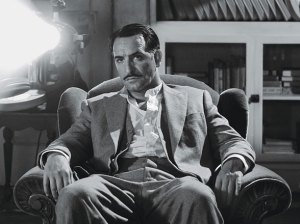
• Thinking about all the above, doesn't it seem true that Michel Hazanavicius based George Valentin on Jean Dujardin somewhat and a bit on John Gilbert...but just as much on himself?
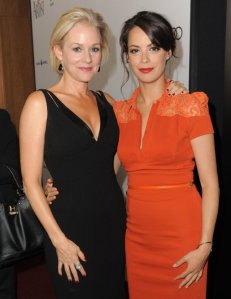
• And isn't just odd and confusing that Hazanavicius named his wife's character Peppy Miller, which sounds so much like just a shorter version of "Penelope Ann Miller"? I can't be the only one who found this weird and distracting, can I?
◊♠♣◊♠♣◊♠♣◊♠♣◊♠♣◊♠♣◊♠♣◊♠♣◊♠♣◊♠♣◊♠♣◊♠♣◊♠♣◊♠♣◊♠♣◊♠♣◊♠♣◊♠♣
Maybe I am the only one who noticed. Either way, here are some facts and observations about The Artist that pretty much just add to the richness of thought I’ve had around the Peppy Miller/Penelope Ann Miller thing and the movie in general. These things just occur to me and are interesting in this context.
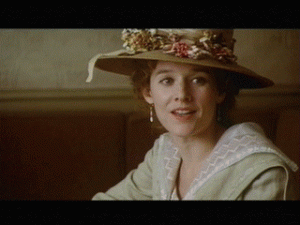
• People have seen Penelope Ann Miller as a silent star before. In 1992, Penelope Ann Miller appeared in Chaplin, Richard Attenborough's biopic about Charlie Chaplin, greatest of all silent film stars. Miller portrayed Edna Purviance, a leading lady in many of Charlie Chaplin's most famous silent movies.
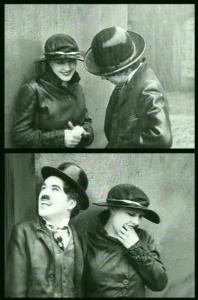
• Charlie Chaplin discovered Edna Purviance sort of by accident, through a friend of a friend. According to one story, Chaplin claimed to a roomful of people that he could hypnotize anyone. He asked Edna to "Fake it," and so she did, just for a laugh, which impressed Charlie. Purviance and Chaplin were romantically involved during Chaplin's ascendancy toward becoming the world's most beloved movie star. He even considered marrying Edna.
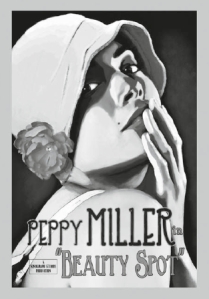
• While writing his silent movie, Michel Hazanavicius used the working title Beauty Spot, based on the distinguishing mark that George Valentin places on Peppy Miller's face—the "something different" that he says she needs to set her apart, to make her a star. Thomas Langmann, the film's producer, insisted on changing the film's title to The Artist. That title puzzled me, I mean, who's "The Artist" in this? George? He's an actor and a bad director, not much of an "artist." Maybe the dog's the artist.... Anyhow, leave it to a producer to saddle a movie—even one mostly about what sets a star apart—with a generic title that barely sets it apart from anything and barely even makes any sense in the first place. Beauty Spot, on the other hand, made so much sense, the film paid homage to its own original title with the poster above, which appears in the film right about when Peppy Miller reaches the height of her stardom.
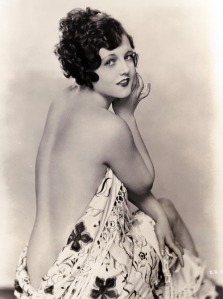
In 1930, Doris Dawson starred in a 21-minute musical called The Beauty Spot. 1930 was still pretty darn early for musicals, and some of The Artist takes place in that year too. I haven't been able to turn up any other info about the movie, beyond its IMDB page. I wonder what it's about, don't you? I also have to wonder if Michel Hazanavicius saw the same IMDB page while writing his script for Beauty Spot.
Super 8 as an Allegory on the Triumph of Digital FX
We’ve all heard by now about how J.J. Abrams’ Super 8 is a big special effects movie that’s grossly indebted to and reverent of the SFX movies of Steven Spielberg. But why exactly? Answer: The film’s subtext is a subtly coded defense of the storytelling power of modern digital special effects characters. Here’s my evidence.
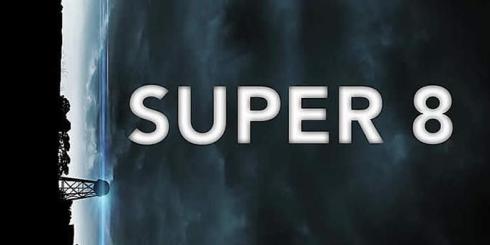 1. “Super 8” = “superate” which means to outdo, to surpass, to exceed. This movie’s subtext is about how digital FX surpasses (but also harkens back to) photographic/analog FX.
1. “Super 8” = “superate” which means to outdo, to surpass, to exceed. This movie’s subtext is about how digital FX surpasses (but also harkens back to) photographic/analog FX.
2. The Super 8 alien is captured, revealed to non-believers, and made real to the characters in the movie (and to the audience) by traditional filmmaking techniques, i.e. the government’s secret black & white footage and the DIY zombie film being made by Charles and the other kids at the train station.
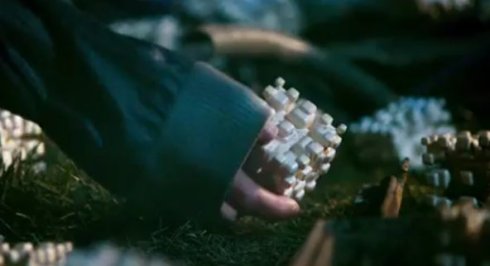 3. The alien’s technology consists of interchangeable discrete little almost-digital units that can be assembled and reassembled with ease to suit the alien’s needs. Metaphorically, these are very like the digital blocks that filmmakers wrangle into movie characters to suit their storytelling needs.
3. The alien’s technology consists of interchangeable discrete little almost-digital units that can be assembled and reassembled with ease to suit the alien’s needs. Metaphorically, these are very like the digital blocks that filmmakers wrangle into movie characters to suit their storytelling needs.
4. The alien’s release at the site of a train wreck represents in metaphor the collision between very old film technique and very new. Way back in the 1890s, films by Thomas Edison and the Lumiere Brothers famously shocked and awed audiences with the very close passings of huge trains at train stations. The kids in Super 8 set an important scene at the fictional Lillian, Ohio’s fictional train station and in doing so capture footage of the digitally rendered and digitally technologically advanced space alien. [I probably won’t go into detail here about how ingrained the “train = filmstrip” metaphor is in film history and in critical thought.]
5. The lens flares the lens flares the lens flares. Sadly, the internet has made more or less a joke out of the lens flares in Super 8. But that’s just kind of stupid and lazy. When a filmmaker makes totally 100% sure that even the most moronic audiences notice some non-plot thing in his film, there’s almost always a solid reason for it. Yes, Super 8‘s lens flares are a constant tribute to a very noticeable stylistic element of Steven Spielberg’s films.
But in Super 8, the lens flares are also a constant reminder of a naturally occurring, photographic, in-camera filmmaking technique—an effect, if you will. Some of J.J. Abrams’ lens flares are real and some were made digitally, apparently, so they serve metaphorically as a link between FX filmmaking’s past and its present/future. At the end of Super 8, the alien’s digitally made ship disappears in a clever, knowing lens flare that’s really one huge, giant nod at Spielbergian FX films of the past, especially E.T. It’s almost like the digitally sophisticated SFX alien is waving farewell to beloved analog FX of old, with a kindly wink of lens flare. To take it a bit further, E.T.’s ship’s departure at the end of E.T. results in an arcing rainbow, one of nature’s own special effects, a trick of real light that sends E.T. home and itself refers back to another home-concerned and rainbow-obsessed FX movie: The Wizard of Oz.
6. And this one’s a bit of a stretch: In the story, all the Super 8 alien has to do to gain a human being’s sympathy and understanding of its plight is to touch that human being. Basically, once it touches you, you no longer fear it, it becomes relatable to you. Metaphorically, a digital FX creature must only make a successful emotional appeal in order to perform the necessary storytelling function, just the way old FX creatures used to. Hence the size and eventual dampness of the Super 8 alien’s window-to-soul eyeballs, which you can only sort of see in the image above. At a key point in the film, the alien’s insectoid eyes soften; they become sentient and emotional, almost anime-level sympathy generators. Or E.T.-level sympathy generators, if you prefer.
There are more subtle bits to this I can’t remember right now, but a lot of the movie’s detail builds toward this allegory. I think that might be why a lot of viewers found the whole thing fairly hokey—Super 8 revives a lot of beloved but hoary tropes in service of a statement about digital FX that it didn’t want to just come all the way out and say. It preferred to be very, very entertaining instead, and slip its “big meaning” right by you. For me, it will be very interesting to see Super 8 again, seeing it the way I do now. And I’ll probably add more to this post once I’ve re-seen it.
You know what the comments are for, so fire away.
Shortest Possible Review™ Volume #1
Yes, Sensei, it’s your Shortest Possible Review™ of The King’s Speech (Hooper, 2010):
“The Kuh-kuh-kuh-kuh-Karate King”
Tapping the Light of Day
People in America aren’t seeing much Light of Day these days. Far as I can tell, 1987’s smallish “Problems of Being in a Cleveland, Ohio, Bar Band” movie has never been available to the US market on DVD. If you want a legit copy of it—and you happen to have a not-so-legit region-free DVD player—go ahead, be my guest: Buy the Region 2 edition for (when last I checked) $199.00 plus shipping. Knock yourself out. Personally, I’m living happily with my beat-up old VHS of it.
I kind of thought that the release of the 2010 film The Runaways, which detailed the formation of Light of Day frontwoman Joan Jett’s early real-life band, would’ve maybe prompted the reintroduction of Light of Day here in the States. Didn’t happen. Still, it’s a pretty decent movie. Joan Jett’s good in it, as Patti Rasnick, lead singer of The Barbusters; Gena Rowlands is her over-religious mom; Jason “The Exorcist” Miller shows up; and Michael J. Fox capably provides lead Barbuster guitar. He and little Benji Rasnick even play an improvised song, “You Got No Place to Go,” on guitar together. And no less a talent than Paul Schrader directed.
When I first came across it not long ago, that last factoid sort of shocked me : Paul “Taxi Driver/Raging Bull/Last Temptation of Christ/Affliction” Schrader had directed an all-but-forgotten Michael J. Fox rock band vehicle I had enjoyed at least twice on late-night cable as a teen? Weird. That same fact also brings me now to the reason for this post.
Last time I watched Light of Day—mostly to see if it was, like a Schrader movie should’ve been, as good as I remembered—I was watching pretty carefully. And I noticed something. Something that referred, without question, to the undisputed king of movies about fictional rock bands. Something graffitied on a punk rock dressing room wall, prominent enough, yet almost hidden among a million other scrawled and spraypainted messages in the background behind Joan Jett’s consternated Patti Rasnick. See if you notice it too:


See that? Right next to the blue shirt? Look here or check out 2:06 in this clip if you prefer moving images I’m not good enough to have faked. SMELL THE GLOVE? Really? That kind of blew my mind, as it would the mind of anyone who’s seen This Is Spinal Tap as many times as I have. Need I even tell you that Smell the Glove (Polymer, 1982) was the (fictional) album that the (fictional) band Spinal Tap spent the better portion of Rob Reiner’s 1984 mockumentary touring in support of? Just for fun, let me quote Bobbi Flekman here as regards Smell the Glove‘s infamous original cover art:
“…a greased, naked woman on all fours with a dog collar around her neck and a leash, and a man’s arm extended out…holding on to the leash and pushing a black glove in her face to sniff it.”
Who, you’re asking, might—if given the chance—advertise crudely on a bar-basement wall for such an offensive and, in fact, non-existent LP? As far as those who must’ve had All Access on Schrader’s Light of Day shoot, I’d say Suspect #1 has got to be Bu Montogomery, bass player for The Barbusters:

Michael McKean as Bu Montogomery, bass player for The Barbusters
See, in Light of Day, Bu Montgomery’s bass was played by none other than actor Michael McKean. Did the whole thing of this post just clang you on the head as hard as it did mine….?
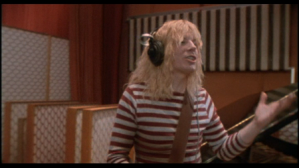
Just in case it didn't: Michael McKean also toured extensively with another band—as David St. Hubbins, lead singer of Spinal Tap!
Nice, legible vandalism on the Light of Day set, Michael McKean! Good job! I’ll bet Smell the Glove is a really cool record! I believe your graffiti has convinced me to go out and buy it!
Hold on though: I don’t want to just post all this and rush off, forgetting to inform you that there’s a fairly intriguing Suspect #2, himself a Clevelander and a big music fan. The kind of guy for whom Smell the Glove and Spinal Tap just might’ve been a pretty big deal, round about 1987. A budding force of nature who himself worked in actual bar bands and as a janitor at Cleveland’s own Right Track Studios. A man whose only film appearance came with 1987’s Light of Day and his blink-and-you’ll-miss-it role as vocalist/keyboardist for The Problems, a local band in competition with Patti and Joe Rasnick and Bu Montgomery’s Barbusters, on stage right there at the Barbusters’ very own home-base bar, the Euclid Tavern. Suspect #2’s name? That would be Trent Reznor:
David St. Hubbins himself sums all of this up as well as anyone probably could:
I believe virtually everything I read, and I think that is what makes me more of a selective human than someone who doesn’t believe anything.
Amen, David St. Hubbins. Amen.





